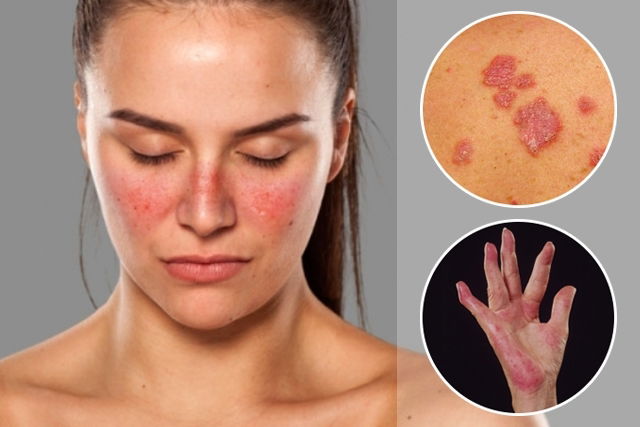Lupus symptoms tend to vary from person to person, and can include pain and swelling in one or more joints, red spots on the skin, excessive fatigue, skin lesions after sun exposure, hair loss, increased light sensitivity, mouth ulcers and nose ulcers.
Lupus symptoms can affect any organs or parts of the body, and can vary from person to person depending on the phase of the disease. They can come and go, and present with alternating periods of flare-ups and remission.
Also recommended: Lupus: Symptoms, Diagnosis, Causes, Types & Treatment tuasaude.com/en/lupusLupus is an autoimmune disease in which the the immune system attacks the body's own cells, leading to inflammation in various areas of the body. It is most common in women between the ages of 14 and 45.

Common symptoms
The main signs and symptoms of lupus are:
- Joint pain, swelling or stiffness
- Muscle rigidity, or lack of flexibility
- Red spots on the skin, particularly on the face (which usually takes the shape of a butterfly wing)
- Fever over 99.5º F (or 37.5º C)
- Excessive fatigue
- Skin lesions after sun exposure
- Painful mouth or nose ulcers
- Chest pain when taking a deep breath
- Difficulty breathing
- Seizures for no apparent reasons
- Hair loss
- Light sensitivity
- Confusion, headaches or memory problems
- Reduce urine output or foamy urine
- General malaise
If any of these symptoms emerge, you should consult a family doctor or rheumatologist for testing to confirm or rule out lupus.
Cutaneous lupus vs systemic lupus
Cutaneous lupus is associated with skin symptoms, particularly on the face and scalp. Systemic lupus, on the other hand, is characterized by symptoms all over body, including the skin, but also affecting the joints, kidneys and hearts. Symptoms tend to be more generalized with system lupus.
Online symptom checker
To assess your risk for lupus, enter your symptoms below:
This symptom checker is just a guide, and does not confirm a true diagnosis. You should consult a family doctor, rheumatologist or dermatologist if you suspect you may have lupus.
Confirming a diagnosis
To confirm a lupus diagnosis, the rheumatologist will evaluate your signs and symptoms. He or she may order testing, like a blood test or urine test, while some cases may require more specific testing, like an echocardiogram and CT scan.
Initial blood testing for lupus usually includes a CBC, urea and creatinine level, as well as antinuclear antibodies to help determine whether autoimmune diseases are present. It is important to note that people with lupus may not always have antinuclear antibodies present in the blood, however.
Lupus tests
The main test results that help to diagnose lupus are:
- High urine protein levels in several urine tests
- Low red blood cell levels
- Leukocytes under 4.000/mL
- Low platelet count in more than 2 blood tests
- Lymphocytes under 1.500/mL
- Positive anti-double stranded DNA or anti-SM blood test
- Positive anti-nuclear antibodies blood test
The doctor may also order tests like a chest x-ray or CT can, echocardiogram, kidney biopsy or skin biopsy to identify whether any inflammatory lesions are related to lupus.
Risk factors
Lupus is related to genetic factors that trigger the immune system to produce antibodies that attack healthy cels in the body. This leads to inflammation in various organs.
Although it is not totally clear why some people get lupus, it appears to be associated with the following risk factors:
- Family history of lupus
- Prolonged sun exposure
- Viral infections
- Hormonal changes during adolescence, pregnancy or menopause
- Using antihypertensives, antibiotics or anticonvulsants
Although these risks seem to increase the chances of lupus, it does not mean that a person with these risk factors will develop it. Therefore, if you suspect you may have lupus or have any related symptoms, you should see a doctor for assessment.
Treatment options
Treatment for lupus should be monitored by a rheumatologist and typically involves the use of medications like anti-inflammatories, corticosteroids or immunosuppressants. The main objective is to relieve system and reduce immune system action.
